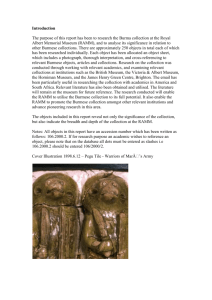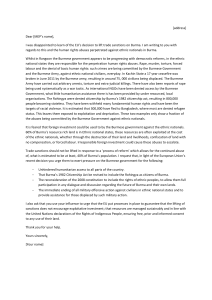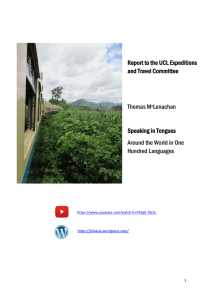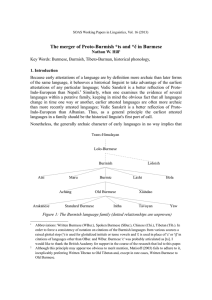Capstone Project Kyaw T. Soe Burmese Parents’ Perspectives Toward Education
advertisement
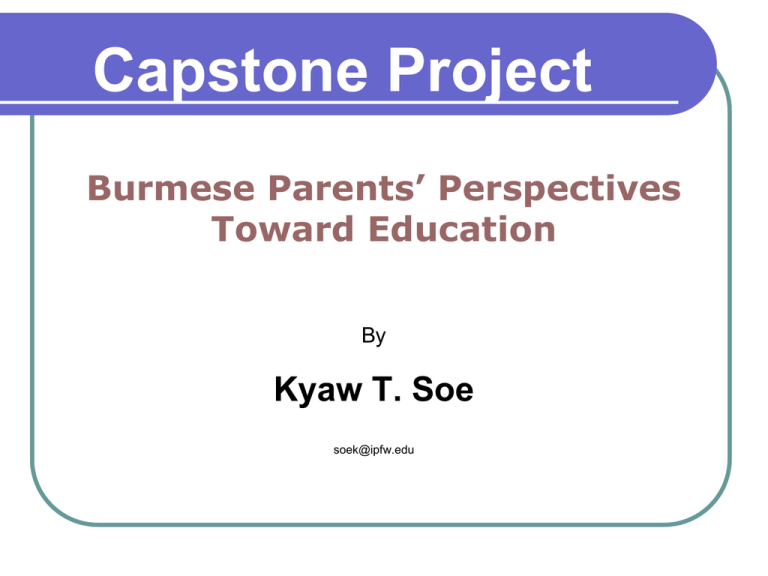
Capstone Project Burmese Parents’ Perspectives Toward Education By Kyaw T. Soe soek@ipfw.edu History Burmese Immigrant in Ft. Wayne Approximately 6,000 Burmese live in Ft. Wayne. The first wave of Burmese immigrants arrived in Ft. Wayne in the early 1990’s. A majority of them were former university students and educated individuals. Today, Burmese immigrants hold a variety of immigration statuses i.e., refugee visas, asylum visas, spouse visas, green card lottery winner visas, etc. Most of the Burmese, who were granted resettlement visas to the U.S., stayed in refugee camps between 1 to 5 yrs or longer before granted visas to a third country like the US. In 2007 to 2008, the largest influx of 1,500 Burmese newcomers arrived in Fort Wayne alone. Purpose of the study To identify educational needs of the Burmese immigrant population in Fort Wayne To share insight, information & concerns regarding Burmese parents’ viewpoints on education, e.g., communication between schools & homes, and access to services and opportunities available To find a common ground for local schools To work together to address the group’s concerns and needs Literature Review Immigrant parents value education and want to help their children to be successful but they do not know how (Thao, 2009). Immigrant parents believe their way of helping their children is preparing them for school and teaching them to work hard and be respectful (Smith, Stern, & Shatrova, 2008). Parents need guidance, schools need to introduce them to school policies, procedures, and grading systems (Rhodes & Paez, 1998). Parents’ high expectations help motivate children’s learning (Zhou & Booth, 2009). Schools are obligated to include parents as partners …. It is a good policy on paper that must be carried out into practice (Mitchell, 2008). Communication strategies must be carefully planned and schools must initiate action (Keanne, 2007). Why is this study important? This is the first pilot study in Fort Wayne that focused on educational needs of Burmese immigrant community. Limited researches/studies have been done in this area; It is hard to find studies on this particular group. The Burmese children are struggling in schools. There is a sense of urgency. Method A survey consisted of 22 questions regarding parents’ opinions related to educational issues. Ten Burmese fathers and eight mothers represented 18 families from the New Immigrant Literacy Program (NILP). Questions and answers were written in Burmese and all written responses/comments were translated into English. Statistical Package for the Social Science (SPSS) was used to analyze the data. Participants Marital Status Ages Gender Gender Ethnicity 20-25 26-35 36-45 Burman Single Married Male - Yes 6 Mon 1 - Yes 1 Kayin 1 - Yes 2 1 - yes 1 1 10 8 1 1 2 Education Level Female 7 Muslim 5 46-55 Gender Total Male Female Elementary 0 1 1 Middle School 4 1 High School 2 Some college Time in the U.S. Total Male Female Less than 2 yrs. 1 2 3 5 5 – 10 yrs. 9 6 15 5 7 11 – 15 yrs. 0 0 0 4 1 5 More than 15yrs. 0 0 0 10 8 18 Total 10 8 18 6 Total 18 Demographics: 100% Married with children 55.6% Male, 44.4% Female 66.7% Barman, 16.6% Kayin, 11.1% Muslim, 5.6% Mon Total Educational background: 5.5% Elementary,27.8% Middle School, 38.9% High School and 27.8% Some College. Time in the US: 22.2% less than 2 yrs, 77.8% stay between 5-10 yrs. Data Analysis I Parents’ Expectation of Their Children’s Education What do you like about America? Starting new life 6% Job opportunity 6% Edcuation opportunity 88% Data Analysis: II Parental Involvement Immigrant parents have different definitions of parental involvement. Parental involvement is not limited to “showingup” at schools’ activities or events. Their expectations and supports should be taken into account. Do you think you are involved in your child's education? Not sure 17% No, I don't. 6% Yes, I do. 77% Do you like to attend your child's school activities? It's not worthwhile. 50% want to be invloved in. 50% Data Analysis III Communication between Schools and Homes How often do you respond to any school survey or letter? Does your child’s school send important documents/ letters home in the language that you understand? Always 22% Seldom 39% Sometimes 39% Always 39% Seldom/Never 39% Sometimes 22% Data Analysis IIII Communication between Schools and Homes (cont.) Do you know your child's teacher and school's contact number? 11.1% No, I don't. 88.9% Yes, I do. Data Analysis V Parents’ Knowledge of Available Services Immigrant parents have depended on classroom teachers to inform and to address their children’s learning progress. Schools and classroom teachers should inform the parents about educational services such as after school tutoring programs. Findings Regardless of the parents’ educational backgrounds, Burmese parents share a similar dream: a college degree for their children. They value education. Schools should be aware of cultural differences. Communicating in the parents’ language helps gain collaboration from the parents; translator and translation services should always be available. Verbal communication would be more effective than documents/flyers. Language is not the only barrier preventing immigrant parents from connecting with schools; cultural differences, lack of knowledge of available educational services and a sense of welcoming at school environments.
